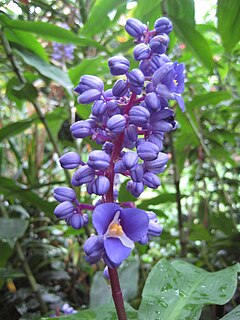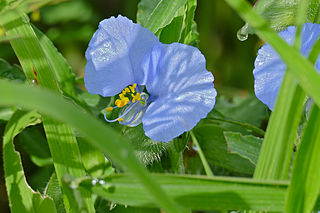Genera list









| Genus Authority | Year | Classification | Type species | # of species | Distribution |
|---|---|---|---|---|---|
| Cartonema R.Br. [1] | 1810 |
| Cartonema spicatum R.Br. | 11 | Australia |
| Triceratella Brenan [2] | 1961 |
| Triceratella drummondii Brenan | 1 | Zimbabwe & Mozambique |
| Palisota Rchb. ex Endlicher [3] | 1836 | Palisota ambigua (P.Beauv.) C.B.Clarke | 18 | Africa | |
| Streptolirion Edgew. [4] | 1845 | Streptolirion volubile Edgew. | 1 or 2 | Himalayas to Japan | |
| Spatholirion Ridl. [5] | 1896 | Spatholirion ornatum Ridl. | 3 | Thailand to China | |
| Aetheolirion Forman [6] | 1962 | Aetheolirion stenolobium Forman | 1 | Thailand | |
| Belosynapsis Hassk. [7] | 1871 | Belosynapsis kewensis Hassk. | 4 | Madagascar, India to New Guinea | |
| Cyanotis D.Don [8] | 1825 | Cyanotis barbata D.Don | 50 | Paleotropics | |
| Coleotrype C.B.Clarke [9] | 1881 | Coleotrype natalensis C.B.Clarke | 9 | Africa, Madagascar | |
| Amischotolype Hassk. [10] | 1863 | Amischotolype glabrata [N 1] Hassk. | 15 | Central Africa, India to New Guinea | |
| Porandra D.Y.Hong [11] | 1974 | Porandra ramosa D.Y.Hong | 3 | China to Thailand | |
| Siderasis Raf. [12] | 1837 ("1836") | Siderasis acaulis [N 2] Raf. | 2-3 | Brazil | |
| Dichorisandra J.C.Mikan [13] | 1820 | Dichorisandra thyrsiflora J.C.Mikan | 25 | Neotropics | |
| Cochliostema Lem. [14] | 1859 | Cochliostema odoratissimum Lem. | 2 | Nicaragua to Ecuador | |
| Geogenanthus [N 3] Ule [15] | 1913 | Geogenanthus wittianus [N 4] (Ule) Ule | 5 | Western South America | |
| Plowmanianthus Faden & C.R.Hardy [16] | 2004 | Plowmanianthus perforans Faden & C.R.Hardy | 5 | Panama to Amazonian Bassin | |
| Tinantia Scheidw. [17] | 1839 | Tinantia fugax [N 5] Scheidw. | 13 | Texas to Neotropics | |
| Thyrsanthemum Pichon [18] | 1946 | Thyrsanthemum floribundum (M.Martens & Galeotti) Pichon | 3 | Mexico | |
| Gibasoides D.R.Hunt [19] | 1978 | Gibasoides laxiflora (C.B.Clarke) D.R.Hunt | 1 | Mexico | |
| Weldenia Schult.f. [20] | 1829 | Weldenia candida Schult.f. | 1 | Mexico and Guatemala | |
| Matudanthus D.R.Hunt [19] | 1978 | Matudanthus nanus (M.Martens & Galeotti) D.R.Hunt | 1 | Mexico | |
| Elasis D.R.Hunt [19] | 1978 | Elasis hirsuta (Kunth) D.R.Hunt | 1 | Ecuador | |
| Gibasis Raf. [12] | 1839 | Gibasis pulchella (Kunth)Raf. | 11 | Neotropics | |
| Tradescantia L. [21] | 1753 | Tradescantia virginiana L. | 70 | New World | |
| Callisia Loefl. [22] | 1758 | Callisia repens (Jacq.) L. | 20 | New World | |
| Tripogandra Raf. [12] | 1837 | Tripogandra multiflora (Sw.) Raf. | 22 | Neotropics | |
| Sauvallea C.Wright [23] | 1871 | Sauvallea blainii C.Wright | 1 | Cuba | |
| Stanfieldiella Brenan [24] | 1960 | Stanfieldiella imperforata (C.B.Clarke) Brenan | 4 | Africa | |
| Floscopa Lour. [25] | 1790 | Floscopa scandens Lour. | 20 | Pantropical | |
| Buforrestia C.B.Clarke [9] | 1881 | Buforrestia mannii C.B.Clarke | 3 | West and Central Africa | |
| Murdannia Royle [26] | 1840 ("1839") | Murdannia scapiflora [N 6] (Roxb.) Royle | 50 | Pantropcal | |
| Anthericopsis Engl. [27] | 1895 | Anthericopsis fischeri [N 7] Engl. | 1 | East Africa | |
| Tricarpelema J.K.Morton [28] | 1966 | Tricarpelema thomsonii [N 8] (C.B.Clarke) J.K.Morton | 8 | India to Southeast Asia | |
| Pseudoparis H.Perrier [29] | 1936 | Pseudoparis cauliflora H.Perrier | 2 or 3 | Madagascar | |
| Polyspatha Benth. [30] | 1849 | Polyspatha paniculata Benth. | 3 | Africa | |
| Dictyospermum Wight [31] | 1853 | Dictyospermum montanum Wight | 5 | India and Sri Lanka to New Guinea | |
| Pollia Thunb. [32] | 1781 | Pollia japonica Thunb. | 17 | Pantropical | |
| Aneilema R.Br. [1] | 1810 | Aneilema biflorum R.Br. | 64 | Pantropical | |
| Rhopalephora Hassk. [33] | 1864 | Rhopalephora blumei [N 9] Hassk. | 4 | Madagascar, India to Fiji | |
| Commelina L. [21] | 1753 | Commelina communis L. | 170 | Cosmopolitan | |
| Tapheocarpa Conran [34] | 1994 | Tapheocarpa calandrinioides (F.Muell.) Conran | 1 | Australia |












